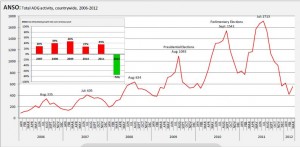First Quarter Violence Down in Afghanistan: Progress or Harsh Winter?

ANSO's data on Armed Opposition Group violence through the first quarter of 2012. (click on image for a larger view)
During his unannounced trip to Kabul today, Defense Secretary Leon Panetta had the unfortunate timing to arrive on the worst day for civilian casualties this year. The Washington Post, however, gave plenty of room for Panetta to cling to the military’s “we’re winning” mantra despite a security situation so bad that his trip could not be announced in advance:
Panetta came to Afghanistan to confer with military leaders on plans to withdraw troops and deal with rising violence. He noted that despite the increase in bloodshed in recent weeks, overall violence was lower than in previous years.
“We have a tough fight on our hands” Panetta said. He reaffirmed the United State’s long-term commitment to Afghanistan and said he believed that commitment would help stymie the Taliban’s ambition.
Over at the New York Times, the headline proclaims “Panetta Visits Afghanistan Amid Mounting Violence” and the article opens by noting the civilian casualties:
Leon E. Panetta, the United States defense secretary, arrived in Afghanistan on Thursday, after the deadliest day for civilians this year and amid controversy over a NATO airstrike the day before in which Afghan officials say 18 women and children were killed.
The article goes on to note, however, that data for the first quarter of this year showed reduced civilian casualties but that reduction may be going away now:
Last week, the head of the United Nations Afghanistan office, Jan Kubis, said that in the first quarter of this year, civilian casualties had dropped for the first time since the United Nations began keeping statistics in 2007. That positive trend has appeared to be eroding in recent days. Another official in the office, James Rodehaver, said, “One thing we can say is that this has been the deadliest day of the year so far for civilians.”
The metric I have followed most closely in monitoring Afghanistan violence has been ANSO’s (Afghanistan NGO Safety Office) reports, and specifically their data on Armed Opposition Group activity. Their latest report (pdf) includes data for the first quarter and a chart summarizing trends in AOG violence over the years in Afghanistan appears above. As seen in the inset, ANSO sees a significant decrease in violence for 2012 over 2011. Their discussion of this decrease is revealing:
For the first time in 6 years the AOG attack growth rate marked a period of regression, for a considerable 74% decrease this quarter (insert chart above). This breaks the established trend in which opposition groups built on their gains, in both geography and capacity, year on year. With last year marking a watershed for the conflict as all actors had their most active on record (see section 1.1), it may be the case that efforts applied by security forces are now having an effect on AOG tactical capacity. However, one must also factor into the analysis that this winter was the harshest in many years, a reality that clearly impacted all sides ability to operate, particularly when considering opposition supply lines. Of course, there could also be an element of unwillingness to commit resources on a fight that is all but over. The final piece of this puzzle is the reality that the conflict is slowly taking on a more political structure as dialogue and talks begin to feature more heavily ahead of 2014. The primary question at present is if this regression has been chosen or forced, a question that will only be fully answered as the year progresses.
Considering how violence now appears to be on a significant upswing, the harsh winter explanation for the decrease in the first quarter is looking like the winning explanation.
Even with the decreased violence in the first quarter, Reuters reminds us today that there are portions of Afghanistan that are so out of control that NATO soldiers in outposts there must resort to the “vampire shift” and carry out all of their activities at night to avoid nearby snipers. And where is this outpost in the profile? From the article:
COP Pirtle-King, or PK, is a low collection of rockfill walls, trenches and camouflage net, built to help secure the sole road running through the strategic Kunar River Valley and intersect insurgent supply routes from Pakistan.
If NATO soldiers are hiding during the day along an insurgent supply route out of Pakistan into Afghanistan, prospects for diminished violence this summer look dim.
As a postscript, all of the press reports I have read on Panetta’s remarks and the situation in Afghanistan tie together Panetta’s observation that the Taliban is now “more organized” in its attacks and a description of yesterday’s suicide bombs. Here is the relevant passage from the Washington Post:
Panetta called Wednesday’s suicide attack “much more organized than we’ve seen before.” According to witnesses, the first bomber on a motorcycle attacked a parking lot often used by NATO supply vehicles in southern Kandahar; a second bomber detonated explosives as others tried to help the wounded.
Hmm. An initial attack followed by a second one aimed at first responders. Where have we heard that before?


The whole world knows that violence drops every winter in Afghanistan. That the US would attempt to snow anyone by citing violence statistics from any 1st quarter in Afghanistan is a childish propaganda effort.
But it is true that all pigs look better with lipstick.
Panetta won’t give the ‘we’re winning’ mantra before it’s obvious to even the Very Serious people that we aren’t winning anything there. I think that the percentage of the population that believes him is probably below 50% now.